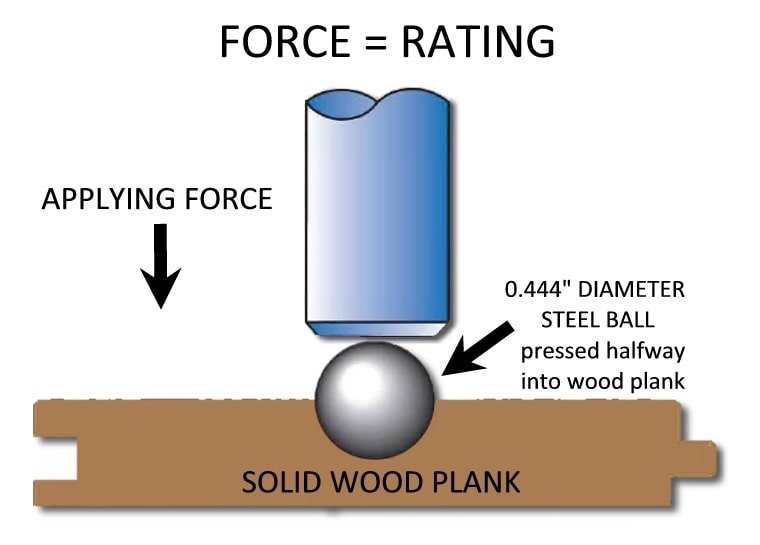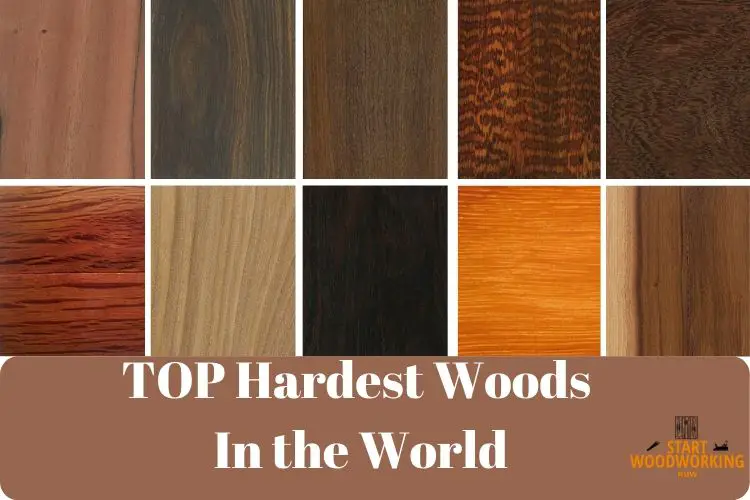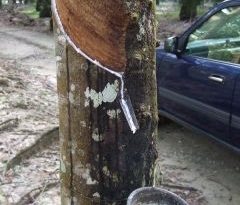Top 15 Hardest Woods in The World [You Won’t Believe #1!]
If we want to start a woodworking project it is important to know the properties of the wood. One of the most important factors is the hardness of wood. So let’s see what are the hardest woods in the world!
Hardness is the property that indicates the precision with which the wood can be worked, by working with different tools as well as the penetration of nails in the wood, but also the resistance to wear.
| Hardest Woods in The World | Janka hardness scale (lbf) |
|---|---|
| 1.Quebracho (Schinopsis spp.) | 4,570 lbf |
| 2. Lignum Vitae (Guaiacum officinale) | 4,390 lbf |
| 3. Gidgee (Acacia cambagei) | 4,270 lbf |
| 4. Snakewood (Brosimum guianensis) | 3,800 lbf |
| 5. Australian Buloke (Allocasuarina luehmannii) | 3,760 lbf |
| 6. Verawood (Bulnesia arborea) | 3,710 lbf |
| 7. Camelthorn (Vachellia erioloba) | 3,680 lbf |
| 8. African blackwood (Dalbergia melanoxylon) | 3,680 lbf |
| 9. Grey Ironbark (Eucalyptus paniculata) | 3,680 lbf |
| 10. Black Ironwood (Krugiodendron ferreum) | 3,660 lbf |
| 11. Curpay (Anadenanthera colubrina) | 3,630 lbf |
| 12. Ipe (Handroanthus spp.) | 3,510 lbf |
| 13. Cumaru (Dipteryx odorata) | 3,330 lbf |
| 14. Desert Ironwood (Olneya tesota) | 3,260 lbf |
| 15. Bulletwood (Manilkara bidentata) | 3,130 lbf |
What is The Hardness Scale of Wood?
Hardness is the property that wood has to resist the penetration of a foreign body stronger than it, which could deform its surface. The hardness of the wood ultimately determines the ease or weight of processing with various cutting tools (planers, chisels, drills) or the penetration of nails, screws.
Specialists who test the strength of wood usually use a special test called Janka strength.

This involves finding the force required (measured in Newtons) to secure a 11.28 mm diameter steel ball to a piece of wood, up to half. This establishes a top of the strongest woods in the world.
Hardness, is that property that indicates the precision with which the wood can be worked, by working with different tools as well as the penetration of nails in the wood, but also the resistance to wear.
Many methods are known for determining hardness, and the classification of wood species by hardness is as follows:
Janka strength test:
- 1000 – very hard wood – examples: guiac, cranberry
- 501-650 – suitable for hard – examples: oak, elm, vanj, castan
- 351 – 500 – semi-hard – examples: birch, walnut, larch, alder
- 201- 350 – soft – examples: fir, lime, poplar, willow, zambru
- <250 – very soft – examples: pine
A very important thing to know is that the hardness of the wood decreases as the humidity increases.
The hardness of the wood is directly related to the density. Thus, the light essences of wood are also the least hard (pine, poplar, willow, spruce), and the heavy ones are characterized by an increased hardness (horn, cranberry).
Here is a list of the top hardest woods in the world :
1. Quebracho (Schinopsis spp.)
The hardest wood in the world is Quebrancho (Schinopsis spp.), which is found in the tropical regions of South America.
The tree is about 1 meter in diameter and 9-15 meters high. The color of this wood varies from shades of light brown to reddish brown.
Long exposed to light, it will darken slightly in color. It is a very hard wood and resistant even to insect attack, being ideal for construction regardless of weather conditions.
Janka hardness score of Quebracho: 4,570 lbf (pound force)
2. Lignum Vitae (Guaiacum officinale)
The second hardest wood in the world comes from an endangered tree species and is recognized as one of the most hardest wood species.
The color varies from olive to dark green and even black. The tree grows in Central and South America. It is very durable and extremely difficult to process.
Janka hardness score of Lignum Vitae: 4,390 lbf (pound force)
3. Gidgee (Acacia cambagei)
The third hardest wood it is a tree native to Australia, having very dark color, and can be used as a substitute for mahogany. But it is much more resistant than this.
Janka hardness score of Gidgee: 4,270 lbf (pound force)
4. Snakewood (Brosimum guianensis)
The fourth hardest wood is also known as “snakewood” because of its texture, which resembles the skin of a reptile. The tree grows in northern South America, in coastal areas, and is quite tall about 20-25 meters.
The wood is extremely dense and has a pronounced blunt effect on cutting machines. It also tends to be quite brittle and can split easily while working
Janka hardness score of Snakewood: 3,800 lbf (pound force)
5. Australian Buloke (Allocasuarina luehmannii)
According to the wood database the fifth hardest wood comes from Australia as the name also suggests.
It has a reddish-brown appearance and because of its hardness, tear-out can happen when planning or surfacing.
Janka hardness score of Australian Buloke: 3,760 lbf (pound force)
6. Verawood (Bulnesia arborea)
It is in sixth place in terms of strength and is a highly sought after wood. It is quite cheap, beautiful, has an olive green color, with a discreet pattern in the form of feathers.
The tree also grows in Central and South America. The wood is very good for the outside, it resists insect attack and direct contact with the ground.
Janka hardness score of Verawood: 3,710 lbf (pound force)
7. Camelthorn (Vachellia erioloba)
The seventh hardest wood in the world it is from Africa and it grows in deep dry sandy soils. It has a reddish brown color and it can grow up to 17 meters tall.
It has a high price for a hardwood and it is usually used as firewood or fence post.
Janka hardness score of Camelthorn: 3,680 lbf (pound force)
8. African blackwood (Dalbergia melanoxylon)
The eight hardest wood has a black color and it’s used to manufacture musical instruments and furniture.
African blackwood is most frequently utilized in turned objects, where it’s considered to be among the very finest of all turning woods.
Janka hardness score of African blackwood: 3,680 lbf (pound force)
9. Grey Ironbark (Eucalyptus paniculata)
The ninth hardest wood is also from Australia. It is primarily used as a quality timber in house framing and flooring.
It is a very hard, strong, and sturdy timber, with a broad range of applications, because of its resistance to lyctid borers and termites.
Janka hardness score of Grey Ironbark: 3,680 lbf (pound force)
10. Black Ironwood (Krugiodendron ferreum)
The tenth hardest wood on our list is Black Ironwood. It is a tree species that belong to the Olive family.
It can have a range of colors like red, orange or brown. And can grow up to 10 meters tall and has a high cutting resistance.
Janka hardness score of Black Ironwood: 3,660 lbf (pound force)
11. Curpay (Anadenanthera colubrina)
It has a dark tan color and it comes from South America. It has a similar weight and hardness as bloodwood.
Because curupay has some interlocking grain it’s difficult to plane and will chip without some special care.
Janka hardness score of Curpay: 3,630 lbf (pound force)
12. Ipe (Handroanthus spp.)
Being an extremely hard and dense wood, ipe wood has a high cutting resistance during sawing. It is also a wood difficult to glue together.
It grows up to (30-40 m) tall and has a reddish-brown color.
Janka hardness score of Ipe: 3,510 lbf (pound force)
13. Cumaru (Dipteryx odorata)
Cumaru is the thirteenth hardest wood in the world, having a very durable decay resistance.
It is a difficult wood to work with because of its high density and interlocked grain. When we saw it would have a blunting effect on tool cutters because it contains silica.
Janka hardness score of Cumaru: 3,330 lbf (pound force)
14. Desert Ironwood (Olneya tesota)
Desert Ironwood is a unique wood species from Mexico that is used for carving trade in Mexico. It has color ranges from an orange yellow to a darker red.
This is a hardwood to work with because of its high cutting resistance. Because it is a unique wood species it is difficult to obtain and dry properly.
Janka hardness score of Desert Ironwood: 3,260 lbf (pound force)
15. Bulletwood (Manilkara bidentata)
The fifteenth and the last hardest wood in the world and in our list is Bulletwood.
Originally from Central America, bulletwood is a hardwood with a red heart, being used for furniture and as a construction material where it grows.
Janka hardness score of Bulletwood: 3,130 lbf (pound force)
Honorable mention is teak wood. Teak wood is the best-known hardest wood.
Even though it is not in the top 15 hardest wood species in the world, teak (Tectona grandis) is the best known.
The tree is native to South Asia and its wood has been used for thousands of years, especially in shipbuilding.
The teak wood can reach up to 40 meters in height, and the color of the wood is reddish.
The harder the wood is, the harder it is to process (especially by hand), the more it opposes the penetration of nails and screws, which it retains better than a less hardwood. Hard species: hornbeam, horn, etc.
What wood lasts the longest?
The durability of wood, which in natural conditions last approximately 200 years after cutting the tree (if not chemically processed), divides the known essences into three well-defined categories:
- very durable wood (oak, yew, elm, pine, thuja, Douglas fir),
- suitable for durable (spruce, fir, ash)
- slightly durable (birch, beech, hornbeam, lime, willow).
As a construction material, wood is used in various forms: finished cylindrical logs, glued laminated wood, paneling, parquet, etc.
From the point of view of durability in direct contact with the ground, untreated natural wood is classified in the following categories:




